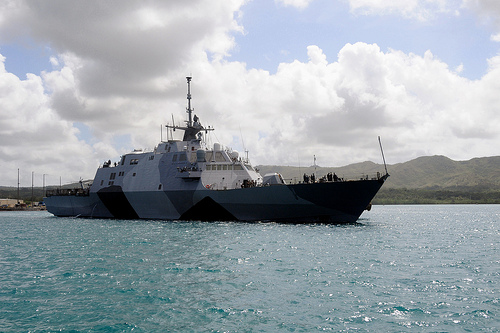LCS: Navy Pushes Back Against Criticisms
Posted on

The first Littoral Combat Ship, LCS-1 Freedom, in Guam.
In a hastily convened conference call with journalists, the Navy pushed back today against recent congressional criticisms of its Littoral Combat Ship.
Yesterday, the LCS program took a 1-2 blow from BreakingDefense, which got a draft of a Government Accountability Office (GAO) report questioning the Navy’s cost estimates to operate it. There was also one from Bloomberg, which had obtained an internal Navy study critiquing the new ship. The two articles drove awkward questions in the House and Senate. (We don’t know whether the two timely leaks were coincidence or a campaign to arm LCS critics for the hearings).
“To some degree people are poking at issues that are old, and perhaps it’s our fault for not having updated them,” said Vice Adm. Richard Hunt, the chairman of the “LCS Council” that the Chief of Naval Operations appointed last year to get the program on track.
The report by Rear Adm. Samuel Perez that Bloomberg cited, for instance, dates to March 2012, as the Bloomberg article acknowledged, and parts of it have been reported before, although Bloomberg’s Tony Capaccio appears to be the first reporter to get the entire document. Many — though not all — of that report’s concerns have been addressed, Hunt said. “[Those concerns] go back frankly a year ago,” he said. “It goes back, frankly to the reason the CNO created the Council… We’ve looked at that stuff, we’ve made adjustments.”
The draft GAO report obtained by BreakingDefense, likewise, criticizes a 2011 estimate of LCS “operations and support costs,” which according to GAO was 90 percent likely to be wrong. “I’m not sure where people come up with the specific percentages of reliability,” Hunt said, but “the program office continues to refine and update those things.”
(What if there was an updated estimate and what it was, Hunt deferred to LCS program and the office of Assistant Secretary for Research, Development, & Acquisition, Sean Stackley. We’ll update you when we hear from them).
“I think we’ve been incredibly open and transparent across the board with GAO,” said Hunt. “I’m not sure what they’re writing, they haven’t given me any insight, [and] I haven’t seen a draft,” Hunt said. “What I would tell you is that I personally met with them several times and I afforded them virtually complete access to anything that we had. We got ’em on board the ships. We showed the documentation, including the classified documentation.”
As for the concerns about the ship’s survivability in combat raised by the Perez report, the Pentagon’s independent Director of Operational Test & Evaluation, and others, the Navy has made some changes, for instance improving the firefighting system and increasing the ship’s “core crew” from 40 to 50 sailors, increasing the number available for damage control. (The main purpose of the larger crew size, however, was to better handle routine maintenance and standing watch). But ultimately, a ship’s ability to take damage is literally built in, a factor of construction and sheer size.
“I think people are expecting every ship out there to have equal survivability in all environments,” said Hunt. “This is not a little destroyer, this is a littoral combat ship with a different mission.” The LCS, with its cannon and 40-knot speed, is more battleworthy than the machinegun-armed, 14-knot Avenger minesweepers it will replace when fitted with its “mine countermeasures module.” When kitted out to hunt hostile submarines, LCS will take the place, not of destroyers, but of the smaller FFG-7 Perry-class frigates, which Hunt himself served on as a young officer.
“When I was on an FFG, people thought that wasn’t survivable,” Hunt said. “I was very comfortable as the damage control officer/chief engineer on those things.”
On the Navy’s 1-3 scale of survivability, by the way, destroyers are a 3, the top rating, while LCS is a 1. Those old Perry FFGs are 2s — still significantly tougher than the LCS.
Subscribe to our newsletter
Promotions, new products and sales. Directly to your inbox.
